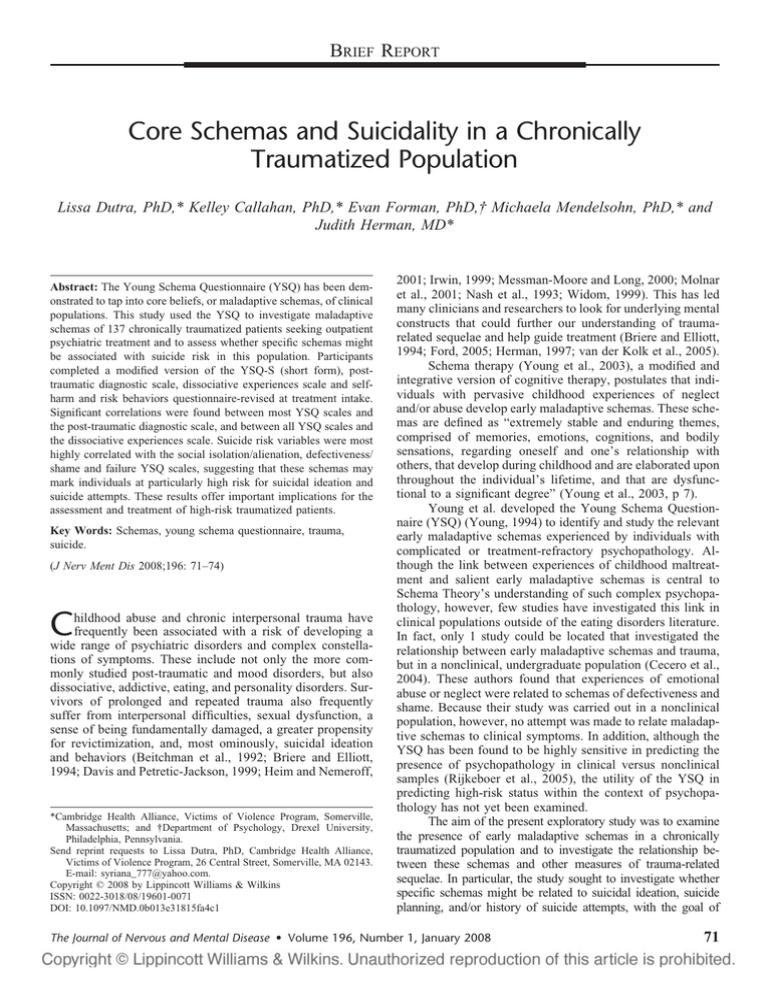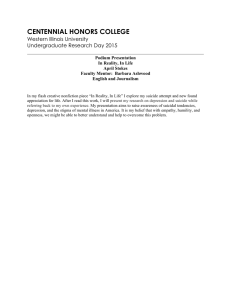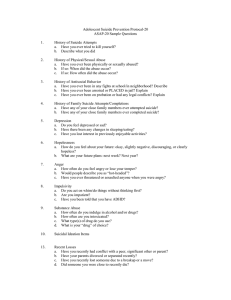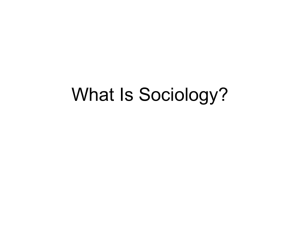Core Schemas and Suicidality in a Chronically Traumatized Population B R
advertisement

BRIEF REPORT Core Schemas and Suicidality in a Chronically Traumatized Population Lissa Dutra, PhD,* Kelley Callahan, PhD,* Evan Forman, PhD,† Michaela Mendelsohn, PhD,* and Judith Herman, MD* Abstract: The Young Schema Questionnaire (YSQ) has been demonstrated to tap into core beliefs, or maladaptive schemas, of clinical populations. This study used the YSQ to investigate maladaptive schemas of 137 chronically traumatized patients seeking outpatient psychiatric treatment and to assess whether specific schemas might be associated with suicide risk in this population. Participants completed a modified version of the YSQ-S (short form), posttraumatic diagnostic scale, dissociative experiences scale and selfharm and risk behaviors questionnaire-revised at treatment intake. Significant correlations were found between most YSQ scales and the post-traumatic diagnostic scale, and between all YSQ scales and the dissociative experiences scale. Suicide risk variables were most highly correlated with the social isolation/alienation, defectiveness/ shame and failure YSQ scales, suggesting that these schemas may mark individuals at particularly high risk for suicidal ideation and suicide attempts. These results offer important implications for the assessment and treatment of high-risk traumatized patients. Key Words: Schemas, young schema questionnaire, trauma, suicide. (J Nerv Ment Dis 2008;196: 71–74) C hildhood abuse and chronic interpersonal trauma have frequently been associated with a risk of developing a wide range of psychiatric disorders and complex constellations of symptoms. These include not only the more commonly studied post-traumatic and mood disorders, but also dissociative, addictive, eating, and personality disorders. Survivors of prolonged and repeated trauma also frequently suffer from interpersonal difficulties, sexual dysfunction, a sense of being fundamentally damaged, a greater propensity for revictimization, and, most ominously, suicidal ideation and behaviors (Beitchman et al., 1992; Briere and Elliott, 1994; Davis and Petretic-Jackson, 1999; Heim and Nemeroff, *Cambridge Health Alliance, Victims of Violence Program, Somerville, Massachusetts; and †Department of Psychology, Drexel University, Philadelphia, Pennsylvania. Send reprint requests to Lissa Dutra, PhD, Cambridge Health Alliance, Victims of Violence Program, 26 Central Street, Somerville, MA 02143. E-mail: syriana_777@yahoo.com. Copyright © 2008 by Lippincott Williams & Wilkins ISSN: 0022-3018/08/19601-0071 DOI: 10.1097/NMD.0b013e31815fa4c1 2001; Irwin, 1999; Messman-Moore and Long, 2000; Molnar et al., 2001; Nash et al., 1993; Widom, 1999). This has led many clinicians and researchers to look for underlying mental constructs that could further our understanding of traumarelated sequelae and help guide treatment (Briere and Elliott, 1994; Ford, 2005; Herman, 1997; van der Kolk et al., 2005). Schema therapy (Young et al., 2003), a modified and integrative version of cognitive therapy, postulates that individuals with pervasive childhood experiences of neglect and/or abuse develop early maladaptive schemas. These schemas are defined as “extremely stable and enduring themes, comprised of memories, emotions, cognitions, and bodily sensations, regarding oneself and one’s relationship with others, that develop during childhood and are elaborated upon throughout the individual’s lifetime, and that are dysfunctional to a significant degree” (Young et al., 2003, p 7). Young et al. developed the Young Schema Questionnaire (YSQ) (Young, 1994) to identify and study the relevant early maladaptive schemas experienced by individuals with complicated or treatment-refractory psychopathology. Although the link between experiences of childhood maltreatment and salient early maladaptive schemas is central to Schema Theory’s understanding of such complex psychopathology, however, few studies have investigated this link in clinical populations outside of the eating disorders literature. In fact, only 1 study could be located that investigated the relationship between early maladaptive schemas and trauma, but in a nonclinical, undergraduate population (Cecero et al., 2004). These authors found that experiences of emotional abuse or neglect were related to schemas of defectiveness and shame. Because their study was carried out in a nonclinical population, however, no attempt was made to relate maladaptive schemas to clinical symptoms. In addition, although the YSQ has been found to be highly sensitive in predicting the presence of psychopathology in clinical versus nonclinical samples (Rijkeboer et al., 2005), the utility of the YSQ in predicting high-risk status within the context of psychopathology has not yet been examined. The aim of the present exploratory study was to examine the presence of early maladaptive schemas in a chronically traumatized population and to investigate the relationship between these schemas and other measures of trauma-related sequelae. In particular, the study sought to investigate whether specific schemas might be related to suicidal ideation, suicide planning, and/or history of suicide attempts, with the goal of The Journal of Nervous and Mental Disease • Volume 196, Number 1, January 2008 71 The Journal of Nervous and Mental Disease • Volume 196, Number 1, January 2008 Dutra et al. identifying schemas significantly associated with a high suicide risk. METHODS Participants Participants were 137 patients seeking individual or group therapy at a treatment program for trauma survivors located in the outpatient psychiatry clinic of a community hospital in a large Northeastern metropolitan area. Eightyfour percent of participants were females, with a mean age of 38.3 (standard deviation (SD) ⫽ 11.2), ranging from 20 to 62-year-old. Seventy-seven percent of participants self-identified as white, 7% African/African American, 3% as Asian/ Asian American/Pacific Islander, and 4% as “Other,” with 7% of the participants identifying as more than 1 race/ ethnicity. Twenty-four percent of the participants were employed full-time, 30% engaged in part-time or occasional work, 25% received disability benefits, and 21% reported no income. With respect to marital status, 52% of the participants were single, 20% married or living with a partner, 13% divorced, and 2% widowed. Measures and Methods Participants called a central outpatient office requesting treatment or were scheduled for intake appointments by their case workers. Clinicians invited patients to complete a packet of self-report measures early in treatment, usually after an intake session of approximately 60 minutes. Clinicians were licensed staff psychologists or social workers, or trainees in these fields being supervised by licensed staff members. Patients had the right to refuse to complete the self-report measures, and the right to refuse permission to include their responses in this study. The study was approved by the Institutional Review Board of the hospital. The Young Schema Questionnaire–short form (YSQ-S) (Young, 1998) was used to assess early maladaptive cognitive schemas. Welburn et al. (2002) carried out a factor analytic study which demonstrated the YSQ-S to have excellent construct validity and good internal consistency. To meet feasibility requirements of this study, the YSQ-S was modified to consist of the 50 highest loading items on the first 12 factors of Welburn et al.’s (2002) study, which represents 12 of the YSQ-S’s 15 original maladaptive schemas: emotional deprivation, abandonment, mistrust/abuse, social isolation/ alienation, defectiveness/shame, failure, dependence/incompetence, enmeshment, subjugation of needs, self-sacrifice, emotional inhibition, and unrelenting standards. Participants rate how well each item describes them on a 6-point scale, with higher scores indicating a greater presence of that maladaptive schema item. The post-traumatic stress diagnostic scale (PDS) (Foa et al., 1997) is a 49-item self-report instrument designed to aid in the diagnosis of post-traumatic stress disorder (PTSD), with its structure and content mirroring the DSM-IV PTSD diagnostic criteria. The PDS’s symptom severity scale was used in these analyses to assess severity levels of the participants’ PTSD symptoms. A cutoff score of 28 on this scale is reflective of symptom severity at a level that is consistent 72 with a diagnosis of PTSD (Coffey et al., 1998; Foa et al., 1997). The PDS has demonstrated good sensitivity and specificity, internal consistency and test-retest reliability, and concurrent and convergent validity (Foa et al., 1997). The Dissociative Experiences Scale (DES) (Bernstein and Putnam, 1986) is a commonly used 28-item self-report questionnaire, developed to assess dissociation in normal and clinical populations. Respondents indicate the percentage of the time they experience particular dissociative phenomena on a scale of 0% to 100% of the time. The overall DES score is based on the mean of all individual item scores, such that the DES total score can range from 0 to 100. van Ijzendoorn and Schuengel (1996) conducted a meta-analytic investigation of 85 studies that used the DES and reported the mean DES score of PTSD patients to be in the low 20s and the mean DES score of dissociative disordered patients to be in the low-to-mid 40s. Ross et al. (1990) reported that nonclinical samples’ modal DES scores tend to hover between 5 and 10. van Ijzendoorn and Schuengel’s (1996) meta-analysis demonstrated the DES to have excellent convergent validity with other measures of dissociation (effect size, d ⫽ 1.82 across 5916 subjects) and predictive validity with dissociative identity disorder (effect size, d ⫽ 1.05 across 1705 subjects), and test-retest reliability (关␣兴 ⫽ 0.93 across 16 studies). The DES has also been shown to demonstrate excellent internal reliability, with Cronbach’s alphas in the 0.90s (Carlson and Putnam, 1993; Frischholtz et al., 1991; Gleaves et al., 2000). The self-harm and risk behaviors questionnaire-revised (SRBQ-R) is an 8-item measure that includes items regarding suicidal and self-harming behaviors, modified from Linehan and Comtoi’s (Linehan MM, Comtois KA (1996) Lifetime Parasuicide Count. Unpublished manuscript. University of Washington, Seattle.) suicidal behaviors questionnaire. The following SRBQ-R variables were used for this study: (a) suicidal ideation frequency: asks respondent how often s/he has thought about killing herself in the past 3 months and is rated on 5-point Likert-type scale, ranging from never to very often; (b) suicide attempt: asks respondent whether s/he has attempted suicide in the past 3 months with “yes” or “no” as response options; (c) suicide plan: asks respondent whether s/he currently has a plan if s/he decided to commit suicide and is rated on 3-point Likert-type scale with 0 ⫽ no, 1 ⫽ yes: a vague plan, and 2 ⫽ yes: a definite plan; (d) self-harm: asks respondent whether s/he has intentionally self-harmed without suicidal intent in the past 3 months with “yes” or “no” as response options; and (e) number of times self-harmed: if respondent endorses self-harming in past 3 months, this item asks how many times s/he has done so during this time period. Data Analysis Descriptive statistics were calculated for each measure. To investigate the association between YSQ schemas and each variable of interest, Pearson r correlations between YSQ scale scores and the PDS, the DES and each item of the SRBQ-R were assessed. Dichotomous variables (e.g. suicide attempts) were dummy coded “0/1” for data analysis. © 2008 Lippincott Williams & Wilkins The Journal of Nervous and Mental Disease • Volume 196, Number 1, January 2008 Schemas and Suicidality in Trauma TABLE 1. Association of YSQ Maladaptive Schema Scales With Posttraumatic Stress Symptoms (PDS), Dissociation (DES), and Suicidality (SBRQ-R); (N ⫽ 107–130) Emotional deprivation Abandonment Mistrust/abuse Social isolation/alienation Defectiveness/shame Failure Dependence/incompetence Enmeshment Subjugation of needs Self-sacrifice Emotional inhibition Unrelenting standards PDS DES Suicidal Ideation Suicide Plan Suicide Attempt 0.37** 0.19** 0.40** 0.33** 0.34** 0.27** 0.09 0.06 0.31** 0.31** 0.42** 0.42** 0.19* 0.29** 0.42** 0.56** 0.56** 0.45** 0.40** 0.22** 0.45** 0.21** 0.36** 0.25** 0.16 0.07 0.15 0.35** 0.44** 0.38** 0.25* 0.06 0.22* 0.13 0.20* 0.20* 0.07 0.18 0.12 0.34** 0.31** 0.35** 0.26** 0.24* 0.16 0.03 0.07 0.11 0.04 0.05 0.06 0.16 0.19* 0.20* 0.02 0.16 0.04 0.08 0.18 0.06 *p ⬍ 0.05, **p ⬍ 0.01. RESULTS The sample’s mean PDS score was 28.2 (SD ⫽ 11.6), which was consistent with reported cut-off scores for individuals diagnosed with PTSD (Coffey et al., 1998; Foa et al., 1997). The most frequent form of trauma was childhood sexual abuse, endorsed by 63% of the sample. In addition, 22% endorsed adulthood sexual abuse, and 47% endorsed childhood and/or adulthood physical abuse. Participants’ mean DES score was 23.1 (SD ⫽ 17.2), reflecting expected scores of individuals diagnosed with PTSD. With respect to suicidality, 5% of the sample (N ⫽ 7) endorsed having attempted suicide over the past 3 months, 23% endorsed currently having a suicide plan (15% endorsed having a “vague” plan and 8% endorsed having a “definite” plan), and 53% endorsed experiencing suicidal ideation. Fourteen percent of the sample endorsed having engaged in self-harming behavior in the past 3 months. Table 1 displays the results of the correlational analyses. As can be seen, significant positive correlations were found between the PDS symptom severity scale and almost all YSQ core belief scales. Significant positive correlations were also found between the DES and all YSQ core belief scales, the strongest of which were found for the social isolation/alienation and defectiveness/shame scales (p ⬍ 0.001). Suicidal risk variables (suicidal ideation and planning) were most strongly correlated with the social isolation/ alienation, defectiveness/shame, failure and dependence/incompetence YSQ scales (p ⬍ 0.01). Suicide attempts, however, were significantly correlated with only 2 YSQ scales: defectiveness/shame and failure (p ⬍ 0.05). Self harm variables (not shown in Table 1) were not significantly correlated with any YSQ scales (r ⫽ ⫺0.17 to 0.14). DISCUSSION This study demonstrated associations between PTSD symptoms and most of the maladaptive schemas assessed by the YSQ. Dissociation was also found to be correlated with a number of maladaptive core beliefs; in particular, the strongest correlations were found between dissociation and sche© 2008 Lippincott Williams & Wilkins mas of social isolation, alienation, defectiveness, and shame. With respect to suicidal risk, the present study found several maladaptive schemas to be significantly correlated with both suicidal ideation and the presence of a suicide plan. Once again the strongest correlations were with schemas of social isolation, alienation, failure, defectiveness, and shame. Importantly, these findings discriminated between suicidality and self-harming behaviors, which were not correlated with any of the YSQ scales. A small number of patients in the present study reported having recently attempted suicide; 2 schemas in particular, those of shame and failure, differentiated this group of high-risk patients from the remainder of the sample. These data suggest that clinicians should be particularly alert to themes of defectiveness, shame, and failure when assessing suicide risk in chronically traumatized patients. The detection of suicide risk in clinical populations is a dilemma that clinicians continuously struggle with, particularly when working with patients who are unwilling or unable to report their risk explicitly. Measures frequently employed to assess suicidality tend to ask respondents to report directly on their own suicide risk. Beyond measures that require self-report of risk status, it would be important to identify additional clinical tools that might be employed to help screen for suicide risk. Moreover, although specific diagnoses may alert clinicians to patients’ vulnerability to suicidality, as in depression (Brown et al., 2000) and schizophrenia (Palmer et al., 2005), clinicians may not be as mindful of such risk in patients with histories of childhood abuse or chronic interpersonal trauma. The present study demonstrates the potential applicability of the YSQ as a supplementary screening tool for suicide risk in traumatized populations. Furthermore, the current findings suggest that clinicians should be particularly attentive to themes of defectiveness, shame, and failure when assessing for suicide risk in traumatized patients. Some patients may be more willing or better able to endorse such schemas, if and when they are present, than to endorse suicidality directly. Future research with nontraumatized clinical populations should be conducted to assess whether the association between suicide risk and 73 The Journal of Nervous and Mental Disease • Volume 196, Number 1, January 2008 Dutra et al. these specific maladaptive schemas is generalizable to other clinical populations. Potential limitations of this study included its use of a modified version of the YSQ-S due to study feasibility limitations, and over-representation of female participants, limiting generalizability of study results. Future research should employ the full YSQ or YSQ-S, and assess potential sex differences in traumatized population’s maladaptive schemas, particularly as they relate to suicide risk. REFERENCES Beitchman JH, Zucker KJ, Hood JE, DaCosta GA, Ackman D, Cassavia E (1992) A review of the long-term effects of child sexual abuse. Child Abuse Negl. 16:101–118. Bernstein EM, Putnam FW (1986) Development, reliability and validity of a dissociation scale. J Nerv Ment Dis. 174:727–735. Briere J, Elliott DM (1994) Immediate and long-term impacts of childhood sexual abuse. Future Child. 4:54 – 69. Brown GK, Beck AT, Steer RA, Grisham JR (2000) Risk factors for suicide in psychiatric outpatients: A 20-year prospective study. J Cons Clin Psychol. 68:371–377. Carlson EB, Putnam FW (1993) An Update on the Dissociative Experiences Scale. Dissociation Prog Dissociative Disord. 6:16 –27. Cecero JJ, Nelson JD, Gillie JM (2004) Tools and tenets of Schema therapy: Toward the construct validity of the Early Maladaptive Schema Questionnaire-Research Version (EMSQ-R). Clin Psychol Psychother. 11:344 –357. Coffey SF, Dansky BS, Falsetti SA, Saladin ME, Brady KT (1998) Screening for PTSD in a substance abuse sample: Psychometric properties of a modified version of the PTSD symptom scale self-report. J Trauma Stress. 11:393–399. Davis JL, Petretic-Jackson PA (1999) The impact of child sexual abuse on adult interpersonal functioning: A review and synthesis of the empirical literature. Aggress Violent Behav. 5:291–328. Foa EB, Cashman L, Jaycox L, Perry K (1997) The validation of a self-report measure for posttraumatic stress disorder: The Posttraumatic Diagnostic Scale. Psychol Assess. 9:445– 451. Ford JD (2005) Treatment implications of altered affect regulation and information processing following child maltreatment. Psychiatr Ann. 35: 410 – 419. Frischholtz EJ, Braun BG, Sachs RG, Schwartz DR, Lewis J, Schaeffer D, Westergaard C, Pasquotto J (1991) Construct validity of the Dissociative 74 Experiences Scale (DES): The relationship between the DES and other self-report measures of the DES. Dissociation. 4:185–188. Gleaves DH, Williams TL, Harrison K, Corrode MB (2000) Measuring dissociative experiences in a college population: A study of convergent validity. J Trauma Dissociation. 1:43–57. Heim C, Nemeroff C (2001) The role of childhood trauma in the neurobiology of mood and anxiety disorders. Biol Psychiatry. 49:1023–1039. Herman JL (1997) Trauma and Recovery. New York: Basic Books. Irwin HJ (1999) Pathological and nonpathological dissociation: The relevance of childhood trauma. J Psychol. 133:157–164. Messman-Moore TL, Long PJ (2000) Child sexual abuse and revictimization in the form of adult sexual abuse, adult physical abuse and adult psychological maltreatment. J Interpers Violence. 15:489 –502. Molnar BE, Berkman LF, Buka SL (2001) Psychopathology, childhood sexual abuse and childhood adversities: Relative links to suicidal behavior in the US. Psychol Med. 31:965–977. Nash MR, Hulsey TL, Sexton MC, Harralson TL, Lambert W (1993) Long-term sequelae of childhood sexual abuse: Perceived family environment, psychopathology and dissociation. J Cons Clin Psychol. 61:276 – 283. Palmer BA, Pankratz VS, Bostwick JM (2005) The lifetime risk of suicide in Schizophrenia. Arch Gen Psychiatry. 62:247–253. Rijkeboer MM, van den Bergh H, van den Bout J (2005) Stability and discriminative power of the Young Schema Questionnaire in a Dutch clinical versus non-clinic population. J Behav Ther Exp Psychiatry. 36:129 –144. Ross CA, Joshi S, Currie R (1990) Dissociative experiences in the general population. Am J Psychiatry. 147:1547–1552. van der Kolk BA, Roth S, Pelcovitz D, Sunday S, Spinazzola J (2005) Disorders of extreme stress: The empirical foundation of a complex adaptation to trauma. J Trauma Stress. 18:389 –399. van Ijzendoorn MA, Schuengel C (1996) The measurement of dissociation in normal and clinical populations: Meta-analytic validation of the Dissociative Experiences Scale (DES). Clin Psychol Rev. 16:365–382. Welburn K, Coristine M, Dagg P, Pontefract A, Jordan S (2002) The Schema Questionnaire-Short Form: Factor analysis and relationship between schemas and symptoms. Cognit Ther Res. 26:519 –530. Widom CS (1999) Posttraumatic stress disorder in abused and neglected children grown up. Am J Psychiatry. 156:1223–1229. Young JE (1994) Cognitive Therapy for Personality Disorders: A SchemaFocused Approach. Sarasota (FL): Professional Resource Press. Young JE (1998) Young Schema Questionnaire Short Form (1st ed). New York: Cognitive Therapy Center. Young JE, Klosko JS, Weishaar ME (2003) Schema Therapy: A Practitioner’s Guide. New York (NY): Guilford Press. © 2008 Lippincott Williams & Wilkins




